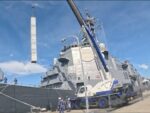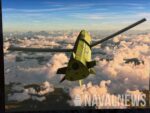Lockheed Martin has revealed it is actively investing its own funds into developing prototype technologies that could shape future iterations of the F-35 Lightning II—potentially culminating in a high-performance “Ferrari” variant. These efforts aim to push the fifth-generation platform beyond its current Block 4 roadmap and position the aircraft for relevance in next-generation air combat environments alongside programs like NGAD.
Lockheed’s Strategic Pivot to Internal R&D Investment
At the Air & Space Forces Association’s Warfare Symposium in February 2024, Lockheed Martin executives confirmed that the company is self-funding advanced technology prototypes for future fighter applications. While specifics remain classified or under wraps due to competitive sensitivity, these prototypes are intended to explore capabilities that may not be funded under current U.S. Department of Defense programs.
Greg Ulmer, Executive Vice President of Lockheed’s Aeronautics division, stated that these internally funded efforts are meant to “bridge the gap” between today’s fighters and tomorrow’s sixth-generation platforms. The company is reportedly leveraging lessons from both the F-22 Raptor and F-35 Lightning II programs while aligning with emerging requirements from U.S. Air Force (USAF) Next Generation Air Dominance (NGAD) concepts.
This marks a notable shift in Lockheed’s posture—moving from primarily government-funded development toward more speculative internal investment. It reflects both confidence in future demand and urgency to maintain technological leadership as adversaries rapidly advance their own fifth-gen and post-fifth-gen platforms.
The ‘Ferrari’ Concept: A High-End F-35 Derivative?
Ulmer hinted at an aspirational vision for a “Ferrari” version of the F-35—one that would prioritize elite performance over affordability or mass production. While he clarified this was not an official program designation, it reflects discussions within Lockheed about how far the platform can be pushed if unconstrained by cost ceilings or legacy requirements.
This hypothetical variant could incorporate technologies such as:
- Adaptive cycle engines from GE’s XA100 or Pratt & Whitney XA101 programs
- Advanced mission systems with AI-enabled sensor fusion
- Next-gen electronic warfare (EW) suites
- Enhanced stealth shaping and coatings
- Cognitive pilot aids and manned-unmanned teaming interfaces
The idea aligns with broader USAF interest in fielding a “Tier I” air dominance capability (NGAD) alongside more affordable Tier II/Tier III platforms like collaborative combat aircraft (CCA). A high-end F-35 derivative could serve as either a bridge or complement to NGAD depending on timelines and budgets.
Block 4 Delays Drive Need for Parallel Innovation
The current Block 4 upgrade package for the F-35—intended to add new weapons integrations, improved sensors (including AN/APG-85 radar), enhanced electronic warfare capabilities, and expanded data fusion—is facing significant delays due to software development challenges. The Technology Refresh 3 (TR-3) hardware baseline required for Block 4 has encountered integration setbacks pushing full-rate production into late FY2025 at best.
This lag has created friction among international partners who expected faster modernization cycles. It also opens space for Lockheed to explore parallel innovation paths outside of government timelines. By funding prototype work independently, Lockheed can test advanced subsystems without waiting on Pentagon acquisition cycles or congressional appropriations.
Moreover, as adversaries like China field increasingly capable systems such as the J-20B with thrust-vectoring engines and long-range AESA radars—and Russia continues Su-57 development—maintaining qualitative edge becomes imperative even before NGAD arrives in numbers post-2030s.
Synergies With NGAD and Collaborative Combat Aircraft Programs
The U.S. Air Force’s NGAD program envisions a family-of-systems approach centered around a sixth-generation crewed platform supported by uncrewed Collaborative Combat Aircraft (CCA). While details remain classified, key attributes include adaptive propulsion, multispectral stealth, modular open systems architecture (MOSA), AI-driven battle management aids, and robust C2/data links.
A self-funded “Ferrari” F-35 could serve multiple roles within this ecosystem:
- A testbed for maturing NGAD-relevant technologies ahead of formal adoption
- An interim solution if NGAD timelines slip past mid-to-late 2030s IOC targets
- A premium export option for close allies unable to access NGAD but seeking advanced capability beyond standard Block 4 jets
The USAF has already signaled openness to fielding multiple overlapping air dominance assets rather than relying on single replacements. This layered approach would mirror naval force structures where legacy platforms operate alongside next-gen ships during transition periods.
Export Considerations and Industrial Implications
If developed into an operational offering rather than just an internal demo effort, a high-end F-35 variant would raise complex export control questions under ITAR regimes—especially if it incorporates sensitive propulsion or EW tech derived from classified programs.
Nations such as Japan—already pursuing indigenous sixth-gen fighter development via its FX program—and Israel—with deep modifications on its own Adir fleet—could be potential customers or collaborators depending on configuration options allowed by Washington. However, cost will be a major factor; any “Ferrari” variant would likely exceed $120–150 million per unit depending on systems included.
From an industrial base perspective, Lockheed’s move signals increased willingness among primes to shoulder early-stage risk typically borne by governments—a trend also seen in Boeing’s MQ-28 Ghost Bat drone co-development with Australia or General Atomics’ Gambit family of autonomous aircraft concepts.
Ahead of Its Time—or Too Late?
The question remains whether such high-end variants will arrive soon enough to impact force structure planning—or whether they risk being overtaken by full sixth-gen platforms before reaching maturity. Much depends on how fast TRL levels rise within these prototypes and whether DoD chooses to onboard them formally via rapid acquisition pathways such as Section 804 authorities or Other Transaction Agreements (OTAs).
If successful though, Lockheed’s initiative could redefine how industry contributes not just hardware but strategic optionality during periods of doctrinal flux—a role increasingly critical amid pacing threats from China’s PLA Air Force modernization drive and evolving joint all-domain operations concepts across NATO allies.










